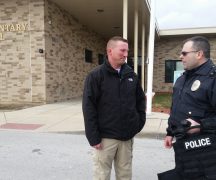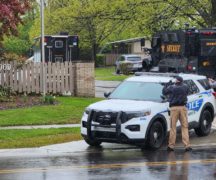By JAN LARSON McLAUGHLIN
BG Independent News
The unsolved murder of Dawn Glanz may be closer to being cracked after the true crime TV show “Cold Justice” investigated the Bowling Green case. The episode aired last Saturday evening.
The Bowling Green Police Division and Wood County Prosecutor’s Office picked up again where “Cold Justice” left off and spent the summer investigating unresolved questions.
Though progress has been made, the prosecutor’s office is still not ready to press charges, according to Wood County Prosecuting Attorney Paul Dobson. But the investigation continues.
“At this point, we haven’t made any decisions,” Dobson said Monday.
Glanz, 66, was found dead in her home on Kensington Boulevard, on May 9, 2013. She had been a professor of art history at Bowling Green State University.
Initially, it was believed her death was the result of natural causes, possibly a stroke. She was found on the bathroom floor. There were no signs of forced entry and nothing was stolen from her home.
However, on the day Glanz’s body was to be cremated, police chief at the time Brad Conner received an anonymous phone call from a woman suggesting that Glanz’s death was not an accident.
The cremation was halted.
An autopsy found that Glanz had been stabbed in the scalp by an assailant using a weapon such as an ice pick or screw driver. It was determined that the stabbing caused her to have a fatal heart attack. However, by this time much of the physical evidence of the crime scene had been cleaned up.
Possible suspects were questioned, but there was not enough evidence to press charges.
So five years later, Glanz’s nephew suggested a rather unorthodox attempt be made to find his aunt’s killer. Dehan Glanz said some new evidence might turn up if the show “Cold Justice” were to get involved.
“The family approached us when the case stalled out,” Bowling Green Police Chief Tony Hetrick said.
Kelly Siegler, a former Houston prosecutor, who leads the investigations on “Cold Justice,” was contacted. She worked with Tonya Rider, a Bowling Green State University professor and retired Toledo detective.
The TV crew spent several days in Bowling Green in October, filming for the show. The primary Bowling Green police officers featured on the show were Det. Brian Houser and Sgt Scott Kleiber.
Also featured were some of Glanz’s fellow art faculty from BGSU, and well as some of her good friends in the Bowling Green community.
During their 10 days in Bowling Green, the “Cold Justice” crew re-interviewed witnesses and brought in their own technical experts.
Those experts were able to determine that Glanz’s husband, Robert Brown, who lived in a separate residence in Toledo, had not told the truth about his last evening with Glanz.
Brown had previously told Bowling Green police that he had last seen Glanz alive after they ate dinner the evening before she was found dead. He said they had eaten food from Five Guys.
However, video recovered from Five Guys showed Brown ordering food by himself that evening and paying an amount that would only be enough for one meal. He exited the restaurant with a small bag and one beverage. Digital experts examined footage from another video camera outside the restaurant and determined that only Brown was in his vehicle.
That evidence was then paired with details that were already noted by Bowling Green police – such as Brown’s 911 call in which he told the dispatcher that he had just arrived at Glanz’s home, and suggesting she may have had a stroke. It had also been noticed that Glanz’s clothing had been straightened out after she was on the bathroom floor.
“The scene was altered,” Kleiber said.
Interviews with friends and co-workers painted a picture of Glanz changing in the months prior to her death. She had married Brown late in life and was being steered by her husband away from her church and into taking medications, they said.
Her financial adviser, Tyne Hyslop, reported that Glanz had repeatedly taken money out of her investment account at the request of her husband. It was also noted that Glanz commented about wanting to stop that drain on her funds. While being interviewed for “Cold Justice,” Hyslop said she was the anonymous caller who suggested to police that Glanz’s death might not be a result of natural causes.
When she died, her husband inherited about $2 million.
Despite repeated efforts, Brown would not speak to the investigators from “Cold Justice.”
Family and friends of Glanz continue to hope the additional information gleaned by the unorthodox investigation will result in justice for Glanz.





